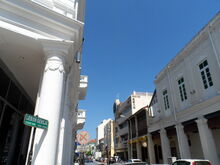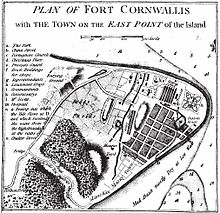
Church Street, George Town
Church Street, within George Town's UNESCO World Heritage Site, is a street within the city's commercial centre. It runs straight from northwest to southeast between Pitt Street and Beach Street.
It was also one of the earlier streets to be laid out in George Town, appearing in a 1798 map of the new settlement. Initially, the street was inhabited by Eurasian Catholics who followed Father Arnaud-Antoine Garnault, a French Catholic priest escaping religious persecution in Siam. Father Garnault also built a makeshift church at the street; the church would later become the Church of the Assumption, which now stands at Farquhar Street.

A Church Street sign. Its official Malay name, Lebuh Gereja, is a direct translation of Church Street.
Towards the end of the 19th. century, Church Street gradually evolved into one of the streets within the commercial heart of George Town. By then, the Eurasians had already moved out of Church Street and were replaced by the Cantonese. The period was also marked by hostilities between Chinese secret societies along the street. In 1893, Kapitan Chung Keng Kwee, the richest man on Penang Island at the time, acquired the former headquarters of his rivals; the site has been transformed into the famous Pinang Peranakan Mansion.
Every Sunday, the Occupy Beach Street event, which aims to promote healthy living and the Penang state government's car-free Sundays initiative, is held and includes Church Street.
Etymology[]
Church Street was named after the Catholic church built by Father Arnaud-Antoine Garnault upon his arrival in George Town in the late 18th. century. At the time, the church was also known as the Portuguese church, due to its Portuguese Eurasian congregation.
When a Chinese secret society, Ghee Hin, established its headquarters at Church Street in the late 19th. century, the Chinese called the street Ghee3 Hin1 Kay1 in Hokkien and Yi Hing Kai in Cantonese. Both terms meant 'Ghee Hin Street'.
History[]

Church Street appeared in this 1798 Popham map of George Town.
Church Street was one of the oldest streets of George Town, having been in existence since the 1790s, soon after Captain Francis Light founded the settlement in 1786. It appeared in a map of George Town created by Captain H. R. Popham in 1798.
After having founded George Town, Light extended an invitation to a French Catholic priest, Father (later Bishop) Arnaud-Antoine Garnault, to settle on the Prince of Wales Island, as Penang Island was then called. Father Garnault and his Eurasian congregation had been escaping religious persecution in southern Thailand. Light accepted Father Garnault's permission to relocate the Catholic mission to the Prince of Wales Island and subsequently dispatched his ship, the Speedwell, to pick up the Catholics.

Church of the Assumption, the first Catholic church in George Town, was once built at Church Street. It now stands at Farquhar Street.
Upon arriving in George Town, Father Garnault established a makeshift wooden attap church at a plot of land bounded by Church Street, Bishop Street, Pitt Street and China Street. It was the first Catholic church to be built in George Town, and was initially called the Portuguese church, due to its mainly Portuguese Eurasian congregation. It would later be named the Church of the Assumption.
In addition, Father Garnault also built an attap shed housing a Malay-language school at the then-swampy Church Street. The school would later evolve into St. Xavier's Institution, the oldest Roman Catholic school in Malaysia.
However, Father Garnault's relations with Light were not always pleasant. When Father Garnault left in 1787, Light wrote to his superiors in British India to request for a replacement. According to Light, 'a Portuguese padre would be better than a French, the latter being too great politicians'.
The Eurasians continued to inhabit Church Street until the mid-19th. century. The Church of the Assumption was demolished in 1857; it was subsequently replaced with the current Church of the Assumption at Farquhar Street. As a result, a number of Eurasian Catholics also moved towards Argus Lane, just behind the new church.
Furthermore, a convent which had been established in 1852 at Church Street was relocated to Light Street, gradually becoming the Convent Light Street we see today. The girls' school is the oldest of its kind in Southeast Asia.
As commerce flourished towards the late 19th. century, Church Street was gradually transformed into a street within the commercial heart of George Town. By then, the Cantonese began to make their presence felt along Church Street by establishing clan associations around the street.

Policemen deployed to control the Penang Riots in 1867. The rioting was sparked by the rivalry between Hai San and Ghee Hin secret societies.
One of the major Chinese secret societies, Ghee Hin, also set up its headquarters at Church Street, earning the street its Chinese nickname - Ghee Hin Street. Its hostility against its rival, Hai San, sparked the Penang Riots in 1867, as well as the Larut Wars in the neighbouring Sultanate of Perak over the monopoly of tin mining there.

The Pinang Peranakan Mansion at Church Street was formerly the residence of Kapitan Chung Keng Kwee, the richest man on Penang Island in the late 19th. century.
In 1893, Kapitan Chung Keng Kwee, the richest man on Penang Island at the time and a Hai San leader, bought the former Ghee Hin headquarters. Chung then built a private temple in honour of himself, as well as the Hai Kee Chan, his residence-cum-office. Today, the Hai Kee Chan serves as the Pinang Peranakan Mansion, showcasing thousands of Peranakan antiques. Recent appearances in Singaporean and foreign television series, such as The Amazing Race, have also elevated its popularity.
Other than the growing Cantonese influence along Church Street, the street also became part of George Town's Little India. Notably, at a time when steamships were the only long-distance mode of transportation, ethnic Indians would converge within Little India to board the MV Chidambara to their hometown in Madras. Therefore, every time the ship docked in George Town, a carnival-like atmosphere would descend on Church Street.

Church Street Pier, off Church Street Ghaut, in the 1930s.
In the late 19th. century, land reclamations extended George Town's eastern shores outwards, creating Church Street Ghaut, an eastward extension of Church Street.
Notable Landmarks[]

From west to east :

- Chong San Wooi Koon
- Pinang Peranakan Mansion
- Kongsoon House

Chung Keng Kwee Ancestral Temple within the Pinang Peranakan Mansion
Hotels[]
- Couzi Couji Boutique Hostel
- ST Hostel
- Church Street Inn

Quiet Please Iron Sculpture, Church Street
Street Art[]
The 'Quiet Please' wrought iron sculpture has been installed near the junction with King Street. It celebrates the history of Church Street.
Its description is as follows.
To the dismay of parishioners of the Portuguese church there, Church Street also housed the headquarters of the notorious Ghee Hin secret society.
Food[]
- B@92 Eat & Drink
- Wa Coffee Cafe
- Eng Loh Cafeteria
- Hwa Pin Cafe
- Old Town White Coffee
Occupy Beach Street[]
Occupy Beach Street is a weekly event in which a stretch of Beach Street between Church Street and Downing Street, along with Church Street, Church Street Ghaut and Bishop Street, are closed to cars and lined with various recreational activities for pedestrians. This initiative by the Penang state government is in conjunction with the car-free day every Sunday.
During the weekly event, Church Street, as the cultural section, will host street performances and a street market, as well as organised tours of the surrounding historic buildings.
Political Representation[]
Penang State Government[]
N.26 Padang Kota State Assemblyman : Chow Kon Yeow (Democratic Action Party)
Malaysian Federal Parliament[]
P.049 Tanjong Member of Parliament : Ng Wei Aik (Democratic Action Party)
References[]
- Khoo S.N., 2007. Streets of George Town, Penang. Areca Books.
- Hockton, K., Howard Tan, 2012. Penang : An Inside Guide to Its Historic Homes, Buildings, Monuments and Parks. MPH Group, Kuala Lumpur.
- Langdon, M. A Guide to George Town's Historic Commercial and Civic Precints. Penang : George Town World Heritage Incorporated.
- http://www.penang-traveltips.com/church-street.htm
- http://wongchunwai.com/2013/08/the-bishop-and-the-french-connection/
- http://wongchunwai.com/2013/04/streets-named-after-places-in-england-remind-the-british-of-home/
- http://wongchunwai.com/2015/10/proud-of-being-multiracial/
